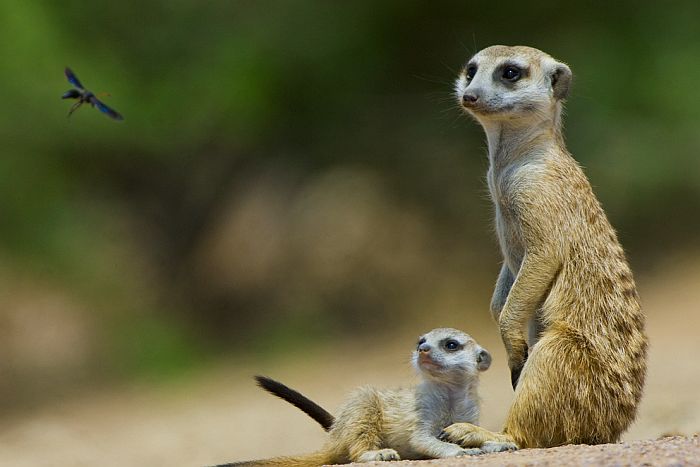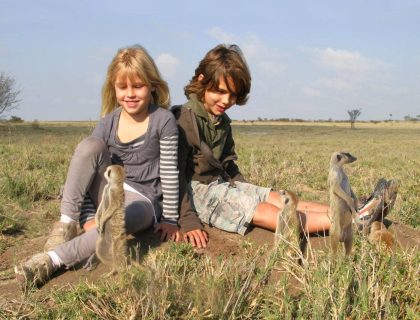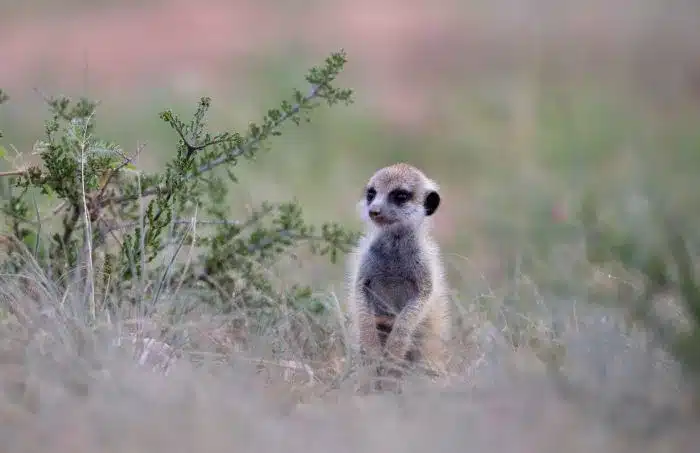Meerkats are some of the most-loved mammals among overseas safari-goers – and with good reason! So where are the best places to find meerkats in Africa?
When you think of meerkats, do you think of Timon from Lion King? And if you couldn’t already guess – thanks to Timon – we are in love with meerkats! Who doesn’t love spotting the long-lost relatives of one of their favourite animated characters in real life? If you haven’t seen the Lion King, don’t worry. We’ll help you fall in love with these cute little guys!
So, without further ado, let us introduce you to the suricata suricatta!
Meerkats of Africa
Appearance:
Meerkats are cute, mongoose-like mammals with a bushy, brown-striped coat, a pointed snout, and a thin tapering tail with a black tip. Their eyes are surrounded by dark patches – perfect to cut down the glare from the sun, allowing them to spot birds and predators far in the distance! They have long, sharp, and curved foreclaws and it is these that make them such experts at digging!
In total, meerkats average about 50cm long. Often perched up on their hind legs, these creatures oftentimes have a curious look on their faces as they take in their surroundings. With a specialised thermoregulation system, meerkats are capable of surviving the harsh desert habitat in which they are born into.
Key Facts:
- Scientific name: Suricata suricatta
- Lifespan (in the wild): 5 – 15 years
- Average weight: 0.62 – 0.96kg
- Tail length: 17 – 25cm
- Head-and-body length: 24 – 35cm
- Top speed: 32km/h
- Gestation period: 60 – 70 days
- Number of offspring: 3 – 7 pups
- Group (mob) size: up to 40 individuals
- Population size: ±500 000 individuals
- Conservation Status: Least concern



What does a Meerkat’s lifestyle entail?
The answer is teamwork!
Extremely social and territorial, these mammals form mobs or gangs of up to 40 individuals, comprising relatively equal numbers of females and males. The mob consists of multiple family units (usually 3 to 4) of pairs and their offspring. Every meerkat takes turns to participate in the mob’s necessary duties – gathering food, keeping a lookout for predators, burrowing, and taking care of the pups and protecting them from rival mobs. Mobs can move collectively in search of food to escape high predator pressure and to avoid floods.
Meerkats live in large burrow systems which they dig out with their long, sharp claws. These burrows provide them with shelter from heat during the day and from predators at night. Burrows can be up to 5 metres in diameter, with multiple entrances, tunnels, and rooms. A mob may use up to five different burrows at a time.
In every mob, there is a dominant male that will try to prevent other males from mating. There is also a dominant female, who births more litters than the other females (subordinates). Generally, the dominant ‘breeders’ will produce offspring while the nonbreeding subordinate ‘helpers’ provide altruistic care for the pups.
Though they may seem cute and cuddly, don’t be fooled! Meerkats can become highly aggressive when they encounter members of different mobs – often resulting in injury and even death.



What do Meerkats eat?
Meerkats are omnivores. They are masters of catching insects, small rodents, snakes, and geckos with lightning swiftness. While foraging, their keen sense of smell helps them locate their favourite insect snacks – beetles, termites, caterpillars, spiders, and scorpions. (Interestingly, they appear to be immune to the venom of certain snakes and scorpions!) Meerkats may also eat birds, eggs, fruits, and plants.
In the dry season (though they barely need extra water in their diets), meerkats will obtain water by digging up roots and succulent tubers.
How do Meerkats hunt?
Every morning, after a session of sunbathing and grooming, the mob emerges from their burrow and begins to forage for food. They forage for approximately five to eight hours per day. While they forage, the mob members vocalize softly to maintain contact. They locate their prey in crevices and under stones or logs with help from their trusty sidekick: their keen sense of smell. Then, they fiercely dig up their catch and feast. They typically don’t give chase to their prey, but they may pursue geckos and lizards over some metres.
When catching scorpions, meerkats grab the arachnid so fast that it barely has a chance to attack. Then, the meerkat bites off the scorpion’s stinger, discards it, and rubs the scorpion in the sand to rid of excess venom on its exoskeleton. A pretty nifty technique, don’t you think? For larger prey, they use their long claws to batter it before tearing it to pieces.
During foraging, at least one meerkat (called a sentinel/sentry) will find a high spot such as a tree branch or termite mound to keep a lookout for predators. While the others dig around for food, the sentinel will sit upright, scanning the sky for eagles and hawks, and the desert for jackals. If danger is sensed, it will alert the rest of the mob with a high-pitched call. The foragers then scatter for cover in their boltholes. Mob members, in no particular order, take turns to keep watch. Talk about teamwork!
Meerkat Joke of the Day:
Question: What did the grape say when the meerkat stood on it?
Answer: Nothing, it just let out a little wine!
Interested in seeing meerkats?
Tell us what you have in mind & we'll create a tailor-made itinerary for you!
Contact Us NowSo, what are the best places to see Meerkats in Southern Africa?
If you are still reading, it means that these cute little meerkats must have stolen your heart! And now you are wondering where you might have a glimpse of these amazing little creatures.
Lucky for you, they can be seen in a large part of Southern Africa – in savannahs, open plains, and rocky areas beside dry rivers in the Fynbos and Karoo biomes. Let’s have a look at the map below.
As you can see, meerkats are mainly found in south-west Botswana, western and southern Namibia, and northern and western South Africa. But they are very shy. So, you may have a chance to see them if you stay at lodges in game reserves within these areas!

Please just note that, given their nomadic nature, meerkat sightings remain relatively rare (quite the opposite of what their non-endangered status suggests!). However, the following reserves do have periodic meerkat sightings:
In South Africa:
- Kgalagadi Transfrontier Park (straddling South Africa & Botswana)
- Tswalu Kalahari Private Game Reserve
- Addo Elephant National Park
In Botswana:
- Kgalagadi Transfrontier Park (straddling South Africa & Botswana)
- Central Kalahari Game Reserve
- Makgadikgadi Pans
Up close and personal – Best places to see Meerkats in Africa
If you are looking for a closer and more personal opportunity to meet some meerkats, then you will be overjoyed to know that selected lodges offer meerkat encounters with habituated mobs. Habituators have spent many hours in the presence of these mobs just to build their trust. The process is slow, but over the course of many years, as the meerkats accept humans as part of their environment, they can finally say that persistence pays off. It is still important to respect their space though!
When visiting habituated mobs, you’ll usually be able to get really close – so close that you might be chosen by one of the mob’s sentries as a vantage point to climb on! You’ll also have ample opportunities to photograph them at their burrow and to follow them around as they forage for food.
The following lodges offer close-up meerkat encounters at sunrise:
- DeZeekoe Guest Farm (Little Karoo)
- Buffelsdrift Game Lodge (Little Karoo)
- The Motse (Tswalu Kalahari Private Game Reserve)
- Camp Kalahari, Jack’s Camp and San Camp (Makgadikgadi Pans)



Tips on increasing your chances of seeing meerkats:
Because wild meerkats are naturally wary of humans and easily spooked, it takes a lot of time and patience to see them. Our best bet is to spend time exploring the specific reserves outlined earlier in this article. Still, there is always an element of luck with sightings, so be patient. They are wild animals with a will and spirit of their own after all!
If you are very keen to see Timon’s relatives though, we recommend joining a sunrise meerkat experience tour. It may not be exactly the same as spotting wild meerkats, but we guarantee that interacting with these habituated fellas are just as special (maybe even more!).
Now that you know that meerkats aren’t just mere cats (pun intended), we hope that meeting them is now on your bucket list! May your future meeting with the suricata suricatta – wild or habituated – be one to remember!
“Best Place to see Meerkats in Southern Africa” – was written by Cedarberg Africa
Cedarberg Africa is a travel and safari company specializing in Southern and East African tailor-made itineraries. As we have special wholesale rates with all the hotels and game lodges, booking through us will cost no more than booking directly, and sometimes less. So, our expertise and knowledge come to you at no extra cost!
Feel free to contact us if you want us to plan a trip that will revitalise your body and mind for you.











